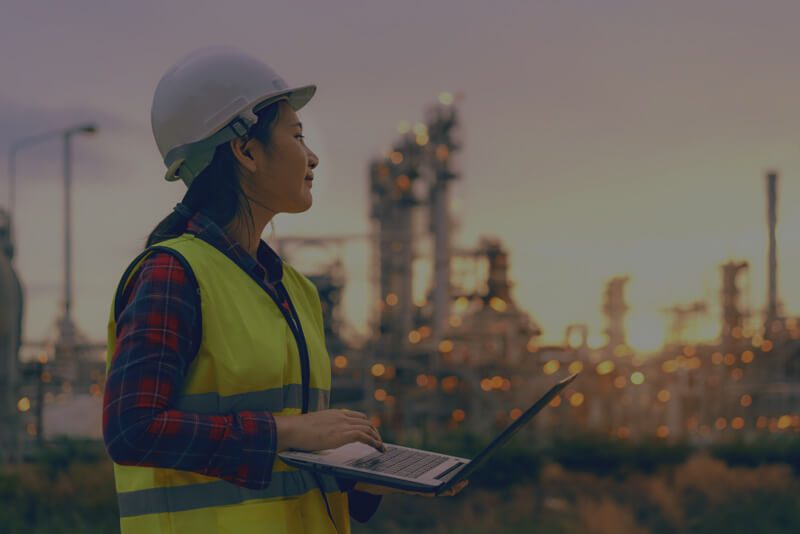In an increasingly demanding regulatory context and with growing environmental awareness, monitoring industrial emissions has become a priority for operators of industrial sites.
Controlling air quality means not only complying with legal obligations, but also ensuring employee safety, protecting the environment and nearby residents, and enhancing the company’s image.
But what does this actually involve? What are the benefits for a company? How can it be implemented? In this article, we answer the most frequently asked questions about monitoring and managing air quality on an industrial site.
Why monitor atmospheric emissions?
Monitoring atmospheric emissions makes it possible to quantify, manage and limit the release of pollutants into the air. These emissions may consist of fine particles, volatile organic compounds (VOCs), acid gases or heavy metals. Failure to monitor them can have serious consequences:
- Regulatory sanctions: environmental standards impose thresholds that must not be exceeded (e.g. IED directive, ICPE in France).
- Health impacts: air pollutants affect the health of residents and employees.
- Increased industrial risks: poor emissions management can indicate a malfunction in the installation.
- Company reputation: a pollution incident can permanently damage the industrial operator’s image.
Monitoring therefore makes it possible to anticipate deviations, reduce risks and effectively manage the site’s environmental performance.
What tools and technologies are available to monitor industrial air quality?
Many solutions exist to implement a reliable and continuous industrial emission monitoring system:
- Continuous analyzers: installed directly on stacks or emission ducts, they measure pollutant concentrations (NOx, SO2, dust, etc.) in real time.
- Remote environmental sensors: they make it possible to monitor ambient air around the site or near sources.
- Industrial weather stations: one of the elements that first allows estimation of the site’s impact zones. Running a dispersion model then quantifies and explains site impacts and the contribution of different sources.
- Supervision software: centralizes monitoring data, stores it, triggers alerts, and generates automated reports. Coupled with modeling, such software can quantify impacts in real time, forecast them, or reduce them during an incident.
How to interpret monitoring data?
Measuring is good, but analyzing and interpreting results is essential for action.
Data must be compared with emission or environmental thresholds defined by national regulations, BAT, the site’s prefectural order, etc. In case of exceedance:
- A rapid diagnosis must be carried out to identify the source (filter malfunction, process variation, peak activity).
- Corrective actions may be decided in real time or scheduled.
- Complete traceability makes it possible to justify the return to compliance to the authorities.
What are the regulatory obligations regarding industrial atmospheric emissions?
In France and Europe, regulations impose strict monitoring of atmospheric emissions. Facilities classified for environmental protection (ICPE) must:
- Implement continuous emission measurement systems for certain pollutants.
- Carry out periodic inspections by accredited laboratories.
- Submit their results to the authorities (DREAL, prefecture).
- Prepare an emission monitoring plan (EMP).
How to optimize air quality management on an industrial site?
Good management requires a proactive approach and continuous improvement. Here are some best practices:
- Automate alerts in case of emission threshold exceedance to react quickly.
- Train teams in reading pollution indicators and intervention procedures.
- Implement an environmental action plan, including maintenance, equipment renewal, and source reduction.
- Analyze data predictively to anticipate pollution peaks.
- Communicate transparently with stakeholders (residents, authorities, partners).
Conclusion: monitoring industrial emissions is at the heart of a responsible and compliant industrial approach.
By relying on the right tools and expert support, each site can combine productivity with compliance with environmental standards.
NUMTECH offers:
- Studies assessing the impact of air quality on public health.
- Software for monitoring industrial emissions and air quality: Plum’Air®.
- Software for monitoring emissions and environmental sensors: Report’Air®.
- Impact studies and industrial atmospheric dispersion modeling.
- Risk studies.
- Support in environmental performance.
As part of the fortil Group, NUMTECH also offers technical assistance or engineering office support to optimize your industrial processes for better control of your atmospheric emissions.

 FR
FR fortil
fortil 
